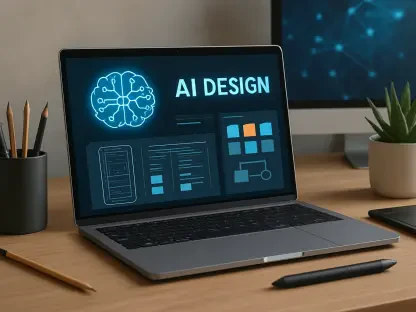Artificial Intelligence (AI) is at a pivotal juncture, rapidly transitioning from a phase dominated by the construction of large language models (LLMs) to an era where the emphasis is on real-world applications and problem-solving. This represents a transformative leap in AI’s evolution, heralding an age where its true potential isn’t defined by the sheer breadth of algorithms but by its tangible, practical uses.
The Shift From Infrastructure to Applications
The initial stages of AI development were characterized by an intense focus on building foundational models, such as LLMs. These large-scale infrastructures laid the groundwork for AI’s current capabilities, providing the base from which more advanced applications could be developed. However, merely expanding these models is now seen as insufficient for driving future innovation. The current trajectory of AI emphasizes practical applications, leveraging these foundational models to address and solve real-world problems. This shift mirrors patterns observed in other technological revolutions, where the early phases focused on developing infrastructure, and subsequent stages witnessed a shift towards utilitarian implementation.
As the technology stabilizes and becomes more accessible, the focus is increasingly on using these tools effectively. This transition signifies a mature phase in AI’s journey, where value is derived from practical use rather than theoretical capability. The landscape is evolving from one where the primary goal was to create sophisticated models to one where the application of those models to produce significant, real-world impacts takes precedence. This perspective aligns with historical technological advancements, demonstrating that the true power of innovation lies in its practical deployment rather than its initial development.
The Decline of Traditional SaaS Models
As AI continues to evolve, traditional enterprise software is witnessing a paradigm shift. The conventional Software as a Service (SaaS) model, which predominantly relies on subscription-based revenue streams, is gradually being overshadowed by AI-native platforms. These advanced platforms have the potential to autonomously manage extensive workflows, thereby reducing or even eliminating the need for human intervention in various business operations. The roles that AI agents are set to assume extend across multiple domains, from negotiating deals and processing legal contracts to managing customer support and optimizing supply chains. This evolution signifies a profound transformation in the operational landscape of businesses.
The implications of this shift are vast, particularly for the services sector. AI-driven solutions are poised to become more prevalent, driving down costs and lowering barriers to entry for businesses. These disruptions, while challenging, also offer numerous growth opportunities for companies willing to adapt and integrate AI into their core operations. The services sector, valued at an estimated $24 trillion, stands on the brink of significant disruption as AI technologies continue to permeate various industries. Embracing this change is essential for businesses aiming to maintain or enhance their competitive edge in a rapidly evolving marketplace.
Economic Disruption and Industry Transformation
AI’s ability to perform tasks traditionally handled by large teams will lead to profound changes in several industries. Starting with marketing and sales, AI’s impact will extend to more regulated professions like law, accounting, and banking. The services sector, encompassing a broad range of activities, will experience massive disruption as AI-driven solutions become more prevalent. Companies must navigate these changes strategically to remain competitive in an evolving landscape. This sector, estimated to be worth $24 trillion globally, provides fertile ground for AI applications to flourish.
The economic implications of AI-driven disruption are far-reaching. As AI continues to advance and integrate into various sectors, its potential to streamline processes, reduce costs, and increase efficiency becomes increasingly evident. This transition requires businesses to rethink traditional models and adapt to new paradigms, where AI plays a central role in delivering value. Adapting to these changes will be crucial for businesses aiming to leverage AI’s transformative potential, drive innovation, and maintain a competitive advantage in the marketplace. As AI reshapes industries, its influence on economic structures will become an essential consideration for decision-makers and strategists.
The Singularity and Its Potential Impact
The concept of “the singularity”—a point where AI surpasses human intelligence—holds the promise of unprecedented advancements. If achieved, the singularity could revolutionize various sectors, including healthcare, biotech, energy, materials, and space exploration. In healthcare, AI could expedite drug discovery, enhance diagnostics, and facilitate predictive care. Genetic engineering and longevity research may see breakthroughs, potentially extending human lifespan and curing previously untreatable diseases. This potential sets a future where AI’s influence extends beyond immediate applications to reshaping fundamental aspects of human life.
The idea of reaching the singularity carries significant implications for numerous fields. In healthcare, the possibilities include accelerated drug discovery processes, advanced diagnostic tools that provide quicker and more accurate results, and predictive care that anticipates health issues before they manifest. Similarly, genetic engineering and longevity research could experience substantial advancements, leading to the development of treatments for previously incurable diseases and potentially extending human lifespans. If singularity is achieved, the transformative impact on these sectors will be profound, leading to far-reaching changes in how we approach health and longevity.
Transformations in Energy, Materials, and Space Exploration
AI-led innovations could lead to smarter battery storage systems, making renewable energy sources more efficient and reliable. Additionally, AI-designed materials could revolutionize construction and aerospace by creating lighter, more durable components, enhancing the overall efficiency and sustainability of these industries. The potential for smarter battery storage systems would address current challenges in energy efficiency, making renewable sources more viable and reducing dependence on non-renewable resources.
Space exploration stands to benefit from AI advancements significantly. With AI-driven systems, missions could become more efficient and safer, addressing current limitations in human space travel and broadening the horizons of exploration. Innovations in material science, driven by AI, could result in lighter, stronger, and more resilient materials that revolutionize industries requiring high-performance components. These transformations underscore AI’s capacity to fundamentally reshape multiple sectors, driving progress and fostering new opportunities for growth and development.
Strategies for Companies to Stay Competitive
To remain competitive in this AI-driven landscape, companies must adopt a proactive approach focused on leveraging AI for more than just enhancement but for fundamental change. Transitioning from traditional SaaS models to AI-native services is crucial for automating entire workflows rather than just augmenting existing processes. As AI reshapes roles within organizations, companies should prioritize hiring AI-native talent skilled in training and managing AI agents, over traditional roles centered on manual tasks. This necessitates a restructuring of traditional departments, evolving them to leaner, more efficient AI-managed units.
Emulating the agile, iterative approach of startups can provide large enterprises with the flexibility needed to deploy AI solutions early and learn from real-world feedback. This strategy allows for continuous adaptation and refinement, ensuring that AI implementations meet practical needs and drive actual value. By adopting these measures, companies can better navigate the complexities of integrating AI into their operations, maintaining competitiveness in a rapidly evolving technological landscape.
Embracing AI as a Fundamental Reshaper
Artificial Intelligence (AI) is at a critical juncture, moving quickly from the phase where creating large language models (LLMs) was the main focus, to an era that prioritizes real-world applications and solving practical problems. This shift marks a significant transformation in the evolution of AI, ushering in a new age where the technology’s true potential isn’t measured by the number of algorithms developed, but by its tangible, practical usefulness. As AI continues to evolve, its impact will become increasingly visible in everyday life, influencing various industries and enhancing the ways we interact with technology. The transition highlights a more practical approach, focusing on how AI can deliver real benefits and address specific challenges across different sectors. This new emphasis on practical applications signifies that the future of AI will be defined not just by its advancements in academic research, but by its capability to solve real-world issues and create meaningful improvements in our daily lives.









